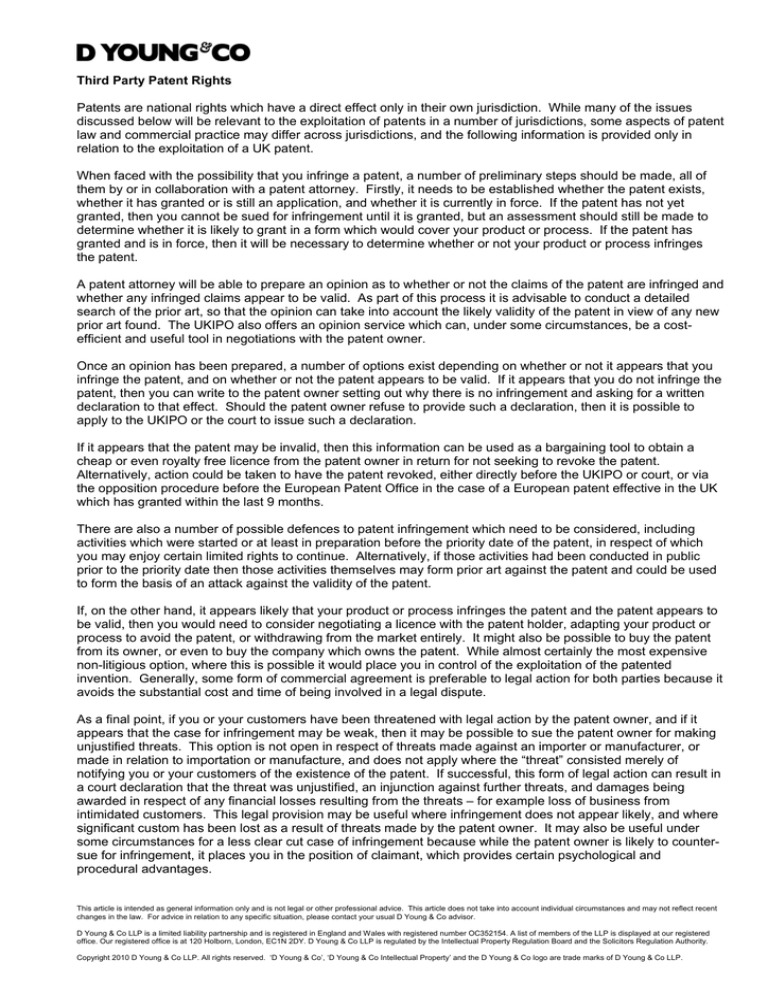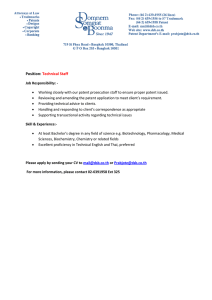
Third Party Patent Rights
Patents are national rights which have a direct effect only in their own jurisdiction. While many of the issues
discussed below will be relevant to the exploitation of patents in a number of jurisdictions, some aspects of patent
law and commercial practice may differ across jurisdictions, and the following information is provided only in
relation to the exploitation of a UK patent.
When faced with the possibility that you infringe a patent, a number of preliminary steps should be made, all of
them by or in collaboration with a patent attorney. Firstly, it needs to be established whether the patent exists,
whether it has granted or is still an application, and whether it is currently in force. If the patent has not yet
granted, then you cannot be sued for infringement until it is granted, but an assessment should still be made to
determine whether it is likely to grant in a form which would cover your product or process. If the patent has
granted and is in force, then it will be necessary to determine whether or not your product or process infringes
the patent.
A patent attorney will be able to prepare an opinion as to whether or not the claims of the patent are infringed and
whether any infringed claims appear to be valid. As part of this process it is advisable to conduct a detailed
search of the prior art, so that the opinion can take into account the likely validity of the patent in view of any new
prior art found. The UKIPO also offers an opinion service which can, under some circumstances, be a costefficient and useful tool in negotiations with the patent owner.
Once an opinion has been prepared, a number of options exist depending on whether or not it appears that you
infringe the patent, and on whether or not the patent appears to be valid. If it appears that you do not infringe the
patent, then you can write to the patent owner setting out why there is no infringement and asking for a written
declaration to that effect. Should the patent owner refuse to provide such a declaration, then it is possible to
apply to the UKIPO or the court to issue such a declaration.
If it appears that the patent may be invalid, then this information can be used as a bargaining tool to obtain a
cheap or even royalty free licence from the patent owner in return for not seeking to revoke the patent.
Alternatively, action could be taken to have the patent revoked, either directly before the UKIPO or court, or via
the opposition procedure before the European Patent Office in the case of a European patent effective in the UK
which has granted within the last 9 months.
There are also a number of possible defences to patent infringement which need to be considered, including
activities which were started or at least in preparation before the priority date of the patent, in respect of which
you may enjoy certain limited rights to continue. Alternatively, if those activities had been conducted in public
prior to the priority date then those activities themselves may form prior art against the patent and could be used
to form the basis of an attack against the validity of the patent.
If, on the other hand, it appears likely that your product or process infringes the patent and the patent appears to
be valid, then you would need to consider negotiating a licence with the patent holder, adapting your product or
process to avoid the patent, or withdrawing from the market entirely. It might also be possible to buy the patent
from its owner, or even to buy the company which owns the patent. While almost certainly the most expensive
non-litigious option, where this is possible it would place you in control of the exploitation of the patented
invention. Generally, some form of commercial agreement is preferable to legal action for both parties because it
avoids the substantial cost and time of being involved in a legal dispute.
As a final point, if you or your customers have been threatened with legal action by the patent owner, and if it
appears that the case for infringement may be weak, then it may be possible to sue the patent owner for making
unjustified threats. This option is not open in respect of threats made against an importer or manufacturer, or
made in relation to importation or manufacture, and does not apply where the “threat” consisted merely of
notifying you or your customers of the existence of the patent. If successful, this form of legal action can result in
a court declaration that the threat was unjustified, an injunction against further threats, and damages being
awarded in respect of any financial losses resulting from the threats – for example loss of business from
intimidated customers. This legal provision may be useful where infringement does not appear likely, and where
significant custom has been lost as a result of threats made by the patent owner. It may also be useful under
some circumstances for a less clear cut case of infringement because while the patent owner is likely to countersue for infringement, it places you in the position of claimant, which provides certain psychological and
procedural advantages.
This article is intended as general information only and is not legal or other professional advice. This article does not take into account individual circumstances and may not reflect recent
changes in the law. For advice in relation to any specific situation, please contact your usual D Young & Co advisor.
D Young & Co LLP is a limited liability partnership and is registered in England and Wales with registered number OC352154. A list of members of the LLP is displayed at our registered
office. Our registered office is at 120 Holborn, London, EC1N 2DY. D Young & Co LLP is regulated by the Intellectual Property Regulation Board and the Solicitors Regulation Authority.
Copyright 2010 D Young & Co LLP. All rights reserved. ‘D Young & Co’, ‘D Young & Co Intellectual Property’ and the D Young & Co logo are trade marks of D Young & Co LLP.


